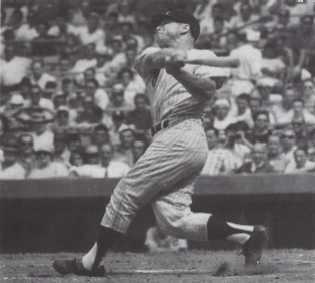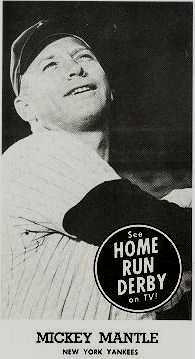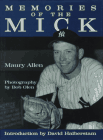|
Copyright ă 2002 Maury Allen.
All Rights Reserved. Ode to Mickey Mantle By Maury Allen |
|
|
Associated
Press The great Mickey Mantle, 1961.
|
|
|
By Maury Allen The
new plaque on the side wall of the old school building on the Upper West Side
of Manhattan first built in 1882 glowed in the early afternoon of a splendid
New York June day. "Mickey
C. Mantle" read the copied autograph in glistening gold and under that
it simply read, "The Mickey Mantle School Dedicated June 4, 2002." David
Mantle, 45, and Danny Mantle, 42, the two surviving of four sons of Yankee
slugger and baseball immortal Mickey Mantle and his wife, Merlyn, held the
strings of the cloth covering the plaque. Now
the audience, assembled on West End Avenue and 82nd Street in
Manhattan in front of the four story school building, could read the plaque. They
had cheered loudly a few moments earlier when a red ribbon was cut by the two
Mantle boys and the obligatory politician on the scene, Manhattan Borough
President C. Virginia Fields, as balloons floated high and school children
applauded. More
than half a century after he first walked on the glistening grass at Yankee
Stadium in 1951, the name of Mickey Mantle would now forever be enshrined in
a New York school, this one for 200 children, mostly minorities, who were
sent to this location as physically or mentally challenged students. "Our
dad suffered from a lot of crippling injuries in his career," intoned
young David Mantle, a significant look-alike for his late father. "One
thing that typified his career was the idea that he would never give
up." Mantle’s
notoriety came, of course, from 18 seasons with the Yankees, 536 homers,
those blond good looks and his flamboyant lifestyle during those winning
Yankee years. As
described in my recent book, "Memories of the Mick" (Taylor
Publishing) Mantle reached an even greater level of attention, affection and
appeal in his final months of life before his death of liver cancer on August
13, 1995. He
took the time then to truly inspire youngsters, to warm them of the evils of
alcohol, a clear factor in his death at age 63, to admit mistakes in his
years as a carousing husband and father, to motivate others to cleaner and
clearer goals. Mantle
had first come to New York with a big reputation as a young power-house and
an attractive shyness naturally earned as a native of a tiny mining town of
Commerce, Oklahoma. His
father, Elvin, called Mutt Mantle by friends, was a zinc miner and he wanted
the fresh air of baseball not the darkness of the mining holes for his son.
He dropped a baseball into his crib and worked with him the next 18 years
until the Yankees took over. Mantle
started in the spring of 1951 in Phoenix, Arizona and his teammate, Joe DiMaggio,
was winding down his career in angered bitterness and just enough jealousy as
attention shifted to the handsome youngster. DiMaggio
made no efforts to welcome Mantle to the Stadium scene but that was typical
of him. He was far too lordly in Yankee lore for any efforts in that
direction. "I
was just afraid of him," Mantle once told me. "I couldn’t talk to
him. That was Joe DiMaggio from crissakes." They
almost collided while both were chasing a fly ball hit by Willie Mays in the
1951 World Series. Mantle suffered knee damage when he stepped into a drain
as he halted his chase of the ball at DiMaggio’s request. DiMaggio
was gone the next year and Mantle took over as team icon. In 1956 he won the
Triple Crown. In 1960 he was joined by Roger Maris and in 1961 they shared
the most dramatic home run chase in history, as they challenged the Babe Ruth
record of 60 homers in 1927, the stupid asterisk ruling concerning 154 games
by Commissioner Ford Frick and the public antagonism. Mantle’s
body, damaged by alcohol and injury, gave out in the middle 1960s and he
walked away from the game with a disappointing .298 lifetime average after
the 1968 season. "I
won’t miss playing," he admitted, "but I will miss being with the
other guys." He
tried several things, broadcasting and coaching among them, private business,
uncomfortable public appearances for pay and card shows in the middle 1980s. A
New York restaurant owner named Bill Liederman convinced Mantle to allow him
to use his name on a new sports hangout. "I
wanted to make Mickey Mantle’s restaurant into the new Toots Shor’s, the
famous sports place of the 1940s and 1950s. Mickey agreed and he really loved
being part of the place," Liederman said. Mantle
would show up at the restaurant, sign autographs, kid with customers,
entertain old teammates and revel in the glory of his past. Mantle
was diagnosed with liver cancer early in 1995. He was placed on a list for a
transplant and, surprisingly, a match was discovered the next day. Some
people howled about that. Others just smiled and quietly said, "It was
for Mickey Mantle." The
cancer had spread and despite a healthy new liver, he passed away in Dallas.
Bob Costas handled the eulogy and reminded the huge crowd that Mantle’s fame
cut across all barriers. "Mick,
we checked the record," Costas quoted St. Peter as saying when Mantle
came to the pearly gates. "We know what went on. Sorry we can’t let you
in. But God wants to know before you go if you’ll sign these six dozen
baseballs." Shortly
after Mantle’s death a school principal named Philip Santise got the idea
that a new name on his school would inspire the handicapped kids. "We
thought of a lot of names like John Lennon who lived in Manhattan and a bunch
of old politicians. Then I thought of Mickey. Why not a Mickey Mantle school?
I started working on it," he said. Seven
years later, chopping laboriously through the New York City school
bureaucracy, he was given approval. The
Mickey Mantle School was engraved in front of what had started as Public
School 9 about 120 years ago. Photos of Mantle filled the halls. The plaque
was built. On
that June afternoon the school band played, "Take Me Out to The Ball
Game," and "New York, New York," before the ceremonies began. Family
and friends spoke of Mantle. The students all seemed thrilled. One
youngster, sitting in a wheelchair, put down his trumpet when the music was
finished. He studied the words on the plaque. "I know who Mickey Mantle
was," he said. "He was a great baseball player and he died too
early." RECOMMENDED
READING: Read legendary
sports writer Maury Allen's moving and beautiful portrait of the great Yankee
powerhouse, Mickey Mantle, a loving memoir of a larger than life hero to a
generation of baseball fans.
NOW
AVAILABLE IN PAPERBACK: CHECK
OUT EVE'S BOOK SHOP: By
Maury Allen, Bob Olen (Photographer) Hardcover/Published
1997 Now
Available in Paperback/2002 |
|


